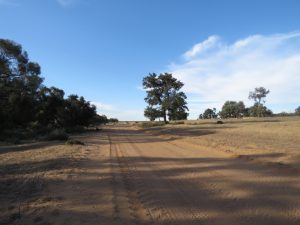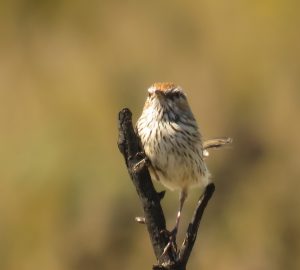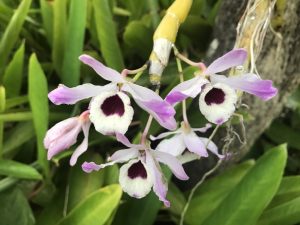11 October 2017
Slept in again. Nice to get a decent nights sleep for a change (i.e., over 8 hours). Overcast skies this morning. We left the Little Desert Nature Lodge and headed to the Grampians National Park. While on the back roads we encounter a lot of birds on the side of the road, primarily Australian Magpies. These birds are like fingerprints – no two birds are alike. Some have a lot of white on their backs, while others don’t. We also saw a Galah (parrot species) on the side of the road. As we were approaching the Galah it Galah stepped back – guess it was afraid we were going to hit it. Smart bird. Lisa and I laughed at that one. Funny to see a bird step backwards.
The day turned to wind and rain. We did stop at several places within the park and tried to bird, including MacKenzie Falls, Reed Overlook, and Boroka Overlook. Not many birds flitting about, although we did seem some black cockatoos in flight. Unfortunately, we couldn’t tell whether they were Red-tailed or Yellow-tailed. We haven’t seen the Yellow-tailed Cockatoos yet.
Stopped off at the Brambuk National Park and Cultural Center to learn about the aboriginal peoples from this region and their plight. I am always amazed at man’s cruelty. Many aboriginals were murdered – either shot or poisoned or died from disease. The young were taken from their homes and sent away to become indoctrinated into white culture. Sad stories, but not unlike in the United States and the treatment of Native Americans.
Ate dinner at the Kookaburra Hotel in Hall’s Gap. Food was expensive and portions were small. A disappointment. And the place was packed. I made a reservation earlier in the day for 6:00 pm (when they opened) or we might not have gotten a table. After eating there it probably would not have been a loss.

Australia Magpie (which really isn’t a mapgie). They vary in the amount of white on their backs. This one has a lot of white.

Grey Currawong


Yellow-faced Honeyeater






MacKenzie Falls


We thought this was a great sign – how to survive the heat. Here I am in my down jacket.



12 October 2017
Left Hall’s Gap – a town where cats are prohibited (so said a sign on the road into Hall’s Gap) – and made our way to the Victoria Coast. We will spend the next three nights in the town of Portland. Our accommodations are nice, although the internet is so slow I could give birth between the time I start a google search and I get any results. Most of the birding we want to do is located to the south and east of Portland.
We stopped in Port Fairy, Victoria. On Sunday we hope to catch a pelagic trip out of here. If the trip had been scheduled for today it definitely would have been cancelled. We had high winds (over 20 mph) and sporadic rain. The ocean had white caps and large swells. I almost got seasick just looking at the ocean. Got to remember to put my seasick patch on the night before our trip. We learn Friday night whether we will be going out on Sunday.
The coast here is beautiful – at least what we can see of it. There is a coastal highway, but not many access points to beaches or rocky outcrops. Lots of private land between the highway and the ocean – mostly farms.
We did get a few new species for the trip, including the Sooty Oystercatcher, which looks almost identical to our Black Oystercatcher; Kelp Gull; White-winged Black Tern; and European Goldfinch. And got to see the Chestnut Teal again. Our only other sighting of this bird was in some mangrove swamps in Brisbane and then only one pair. A lot more here.


A “don’t feed the kookaburra” sign or is it all birds – in Hall’s Gap

Kangaroo with its Joey – behind our lodge

Galahs – wow look at that deep pink color

Sulphur-crested Cockatoo

European Finch

This is not a sea jelly


Beach at Port Fairy

Little Black Cormorant

Black Swan and Cygnets

Two Chestnut Teals roosting

The beach near Port Fairy

Stormy day

Protect the “Hooded Plover” signs found along the beaches

Liked this sign showing which sections of the beaches dogs are allowed




Australian Raven

Sharp-tailed Sandpipers

White-headed Stilt

Hoary-eared Grebe

Coastline between Port Fairy and Portland


No hidden bird, just interesting vegetation. Birds do like it, but none that we could see.

Trail

Coastal heath



13 October 2017
Visited the Fawthrope Lagoon in the am to check out the rails and crakes. Didn’t see any where I expected them to be found. We met a couple on the trail that said they had yet to see them this year. Darn. They fear the feral and domestic cats are to blame for their disappearance. Cats are a real big problem in Australia.
When you read about places to bird in Australia, especially in books that have been in print for several years or more, you don’t know whether you will find the birds there or not. I tried getting on eBird Australia, but with our slow internet connection at the place we are staying, I wasn’t able to find out where best to see those birds. We did do a nice 2.2 km walk around the lagoon – in our down jackets and wind pants, passing people in short sleeved shirts and tank tops. Really!!! Of course when you are stopping all the time to check out the birds instead of continually moving, it gets cold.
From Fawthrope Lagoon we drove to Cape Nelson State Park, finding the Rufous Bristlebird along the road along with several other birds. The Rufous Bristlebird doesn’t seem to fly when flushed. It walks. We only realized this when we nearly ran over one the birds. At Cape Nelson State Park there is a lighthouse. We walked around the lighthouse, checking out the pelagic birds along the way. Most of the birds flying out over the ocean were Short-tailed Shearwaters. They nest near the Gannet colony, east of the park. There were a number of Australasian Gannets flying out over the water too. We finished up at the park with a 3.3 km sea coast walk with great views of the coastline.

Fawthrope Lagoon

Little Wattlebird

Male Chestnut Teal

Mallard hybrid

Red Wattlebird

New Holland Honeyeater


Rufous Bristlebird

Grey Shrike-thrush …

… breaking out in song. It does have a lovely song.

Our trail











Grass trees with its “kangaroo” tail

Up close view of the “tail”

Sorry but I think wind turbines are visual vandalism


Beautiful coastline near Portland, Victoria


Brown Thornbill


Singing Honeyeater

White-necked Heron

Crested Tern
Leaving the park, we headed to the Australian Gannet colony, located at Point Danger approximately 6 kilometers from Portland, Victoria. This colony is the only mainland Gannet colony in Australia. I read where they used dogs to help control the foxes. Foxes are another big problem for wildlife in Australia.
As we were walking to the vantage point for the Gannet colony, we ran into a gentleman who told us he could get us closer. We took him up on the offer. We were able to get about 20 feet from the colony. Many of the birds were on nests, with the young birds on the periphery trying to find their own mates. Their mating rituals remind me somewhat of the Laysan Albatross at Midway National Wildlife Refuge. The birds put their beaks under their wings, as if the are sniffing their wing pits. They don’t do the bill clacking that the albatross does, however.
The mainland colony has about 300 birds, according to Ewen, our host. In among this group of Australasian Gannets are several Cape Gannets. It took some effort for me to tell the difference – very subtle with a brighter blue eye, larger black skin around that eye, and a black chin mark that drops further down the chest than the Australasian Gannet. We spent about 30 minutes enjoying this spectacle of birds. Truly an amazing experience.












This gannet is a Cape Gannet






14 October 2017
A woman we met yesterday, Wendy at the Gannet colony, said the Henty Bay Caravan Park beach was a good place to see Hooded Plovers. There are only around 600 of these birds left in the world. The birds nest on the beach and must compete with beach goers, dogs, and horses for use of the beach. No wonder there are so few birds.
We drove to the beach, but the tide was high. We kept wondering where the birds would nest as the water came all the way up to the bluffs or rocks. Best come back when the tide was low, and the chance of seeing a plover would be greater – if they are even here. We didn’t ask what time of year she saw them.
The couple we met yesterday at Fawthorpe Lagoon spoke of blowholes, a petrified forest, and seal colony near Bridgewater Bay, a short 12 kilometers from Portland. So off we went to search of some of the heath birds (Southern Emu-wren, Olive Whistler, Brush Bronzewing) species that might be in this area. No luck. We did stop off and see the blowholes. Impressive, but nothing like you see on the Oregon coast. We also checked out the petrified forest, which really isn’t a forest at all, but rather limestone rocks that have been eaten away by water – still interesting geology.
Looking out over the ocean we did see a whale, but it was too far away to identify. It could have been a Blue Whale, Southern Right Whale, Humpback, or a Minke Whale. Generally the Blue Whale appears in November, with the Bonney Upwelling – where the ocean waters cool (upwelling), bringing in krill, which the whales and seabirds feed upon. While watching for the whale spout, we saw hundreds and hundreds of Australasian Gannets plummeting into the water (maybe the upwelling is ahead of schedule) for food. It looked like a whirlpool of birds going into the water. Fascinating to watch. Then sudden the birds left. Since they were gone, we decided to also leave.
Our next stop was at Shelly beach. I think the beach got its name from all the shells on the beach. In some places the shells were several inches deep. We were hoping to see Hooded Plovers here as it didn’t look like the beach got much traffic. Unfortunately, no Hooded Plovers, but we did see a single Pied Oystercatcher. I love Oystercatchers, so wasn’t too disappointed. When I say “wasn’t too disappointed”, one of the birds I really wanted to see on this trip was the Hooded Plover. Might have had a better chance of seeing them down around Philip Island, southeast of Melbourne. Maybe if I ever return to Australia I will go there. What do you say Jack?
Back to Henty Bay Caravan Park we went to search for the Hooded Plover. While there was some beach, there were no plovers. Can’t always get the birds you want. However, these birds can also be found along the coast in Western Australia and that is where we are headed next. Fingers crossed.
Tomorrow is our pelagic trip. And since it is going to be a long day (up at 5:00 am, out the door at 5:15, on the boat at 6:45 am, off the boat around 4:30 pm, and a 4+ hour drive to Melbourne Airport), we decided to take the afternoon off to pack, relax, and just veg.

Interesting cave we saw

Bridgewater Bay

Petrified Forest






Silvereye in the parking lot

Singing Honeyeater

Pied Oystercatcher at Shelly Beach

Shelly Beach

Black-faced Cormorant

15 October 2017
The Pelagic Trip – maybe I should call it the tragic trip since I got seasick. I used a seasickness patch, but I guess the swells were just too much for me. Or maybe I can blame it on the chocolate chewy cookies Neil, the organizer of the trip, brought. Lisa and I are scheduled to go on another pelagic trip out of Sydney, but I’ve already put her on notice she is going alone. I’m done with pelagic trips. Nothing I hate more than being nauseous. The trip was nine hours long, and since I started feel off about three hours into the trip, the trip actually seemed like it was nine days long. While I got a few new life birds, I’m not sure it was worth it.
We actually motored out to the continental shelf, put shark liver and tuna oil into the water to draw the birds into a feeding frenzy, only it didn’t work. The birds came close, but only a few landed on the water to grab the goodies, and those were a fair distance off. Most of the people on the boats had huge lens so they were a little disappointed they couldn’t get the eye ball shots of the birds (or so I am assuming). I think if I had tried to take photos I would have gotten sicker a lot faster. Oh wait, I did take a few photos, but by then I was already queasy.

Our boat – Southern Exposure

Motoring out of the harbor at Port Fairy

A few of the people on our tour

Shortly after sunrise

The First Mate cutting up the offal

Cape Petrel – a beautiful seabird species when in flight

Lisa on our way back into port
After the trip, we drove four hours to Melbourne. Some where between our accommodations in Portland to our accommodations in Melbourne, I lost one of my bird field guides – the one I had been keeping track of the birds I’ve seen on this trip. Lucky for me I’ve also have a list on my computer, my Australia bird app, and my notebooks. I always write down the birds I seen in a particular area in my Write-in-the-Rain notebooks. When I was in Vietnam in late 2011 I left a notebook on the train. While I had checked off the birds on my book, I don’t know where or when I saw them. This note book contained the birds seen in Thailand, Bhutan, and northern Vietnam. I lost a lot of good information when I lost my notebook. So now I keep several lists just in case.
Our next stop is Perth and point south. We should seen some new birds, although not many. Until then …
IT’S A GREAT DAY TO BIRD





















































































































































































































































































































































































































































































Recent Comments